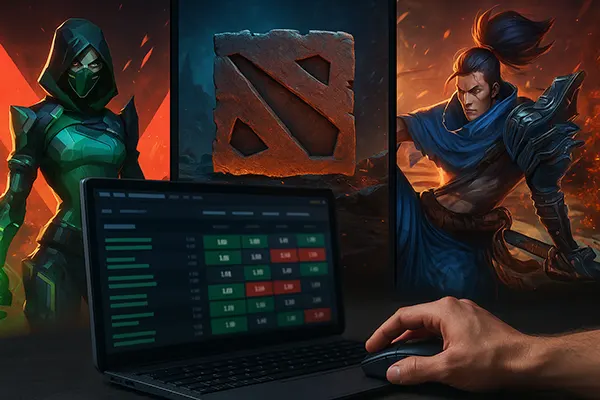Esports Betting Beyond CS:GO: Market Analysis of Valorant, Dota 2, and LoL

While Counter-Strike: Global Offensive has long dominated the esports betting landscape, the market has significantly diversified by mid-2025. Valorant, Dota 2, and League of Legends (LoL) have each cultivated mature competitive ecosystems and drawn considerable betting interest. This article provides an in-depth comparative look at these three titles and their performance within the esports betting sector.
Betting Markets and Tournament Structures
Each title offers a distinct competitive structure that influences the diversity and frequency of available bets. Valorant’s VCT (Valorant Champions Tour) has adopted a tiered, international format with franchised leagues, providing stable betting opportunities throughout the year. In contrast, Dota 2 maintains its open system with The International still anchoring its ecosystem, but with smaller regional events becoming more frequent post-2023. LoL’s LoL Esports circuit operates on a franchised seasonal basis with regional splits and international events like MSI and Worlds.
From a bettor’s perspective, LoL and Valorant offer predictable scheduling and odds availability due to consistent formats and regular fixtures. Dota 2’s schedule can be harder to navigate, yet it often yields higher volatility in odds due to roster instability and open qualifiers. These dynamics make LoL and Valorant more attractive for consistent engagement, while Dota 2 attracts value seekers looking for upsets.
The number of betting markets per match also differs. LoL leads with around 30–40 unique bet types per game, including first blood, first turret, and kill spreads. Valorant follows closely, while Dota 2 still struggles to provide consistent side markets outside match winner and total maps due to complex game mechanics and shorter match cycles.
Franchise Stability and Regulation
Regulatory infrastructure impacts betting safety and market consistency. Riot Games (LoL and Valorant) have implemented strict franchising rules, creating long-term team partnerships and predictable match schedules. This allows sportsbooks to plan ahead and maintain consistent coverage. Valorant’s move into APAC and Latin America markets in 2025 has further increased betting liquidity across new regions.
Dota 2, managed by Valve, lacks centralised control, leading to frequent third-party tournaments with varying standards. This inconsistency introduces risks for both sportsbooks and bettors. However, Valve’s recent implementation of the Dota Team Rating System (DTRS) aims to classify teams by reliability and historical match integrity, improving confidence gradually.
From a legal perspective, LoL and Valorant betting is now regulated across most of Europe, the UK, Australia, and Canada. Dota 2 remains restricted in several jurisdictions due to match-fixing incidents between 2021–2024, despite renewed compliance initiatives.
Player Base, Streaming Popularity and Odds Dynamics
Audience size and viewer engagement directly affect odds shaping and market depth. In 2025, League of Legends remains the most-watched esports title globally, with consistent Twitch viewership exceeding 300,000 concurrent during major events. Valorant follows closely, benefiting from a younger demographic and high engagement via stream-integrated betting tools.
Dota 2 has experienced declining viewership outside Southeast Asia and Eastern Europe, with sporadic peaks around The International. This volatility affects odds accuracy due to limited betting volume and trader data. In contrast, LoL and Valorant offer more robust data pipelines that enable better-informed odds modelling and in-play betting reliability.
Betting platforms increasingly use AI-driven pricing engines. Riot-powered titles (LoL and Valorant) offer live stats APIs and betting feeds that support dynamic lines and micro-bets. Dota 2’s fragmented ecosystem makes real-time data integration difficult, limiting the offering of prop bets and live bet types.
Demographic and Betting Behaviour Insights
LoL bettors tend to be between 24–35 years old, often placing small to medium stakes with a preference for combination bets across multiple regions (e.g. LEC, LCK, LCS). This group values predictability and uses historical data extensively when betting.
Valorant’s audience skews younger (18–28), more risk-seeking, and highly mobile-focused. These users are more likely to bet via apps and try novel bet types such as round handicaps and first-kill wagers. Social sharing of betslips is also more common in Valorant communities, influencing behaviour patterns.
Dota 2 attracts a niche, loyal segment that often bets with higher variance strategies. These players favour outright bets on underdogs and rely on insider knowledge of roster changes, particularly in lesser-known regional events. However, lower trust levels due to past scandals limit casual bettor expansion.

Commercial Partnerships and Market Expansion
Sponsorship and sportsbook integrations have fuelled betting growth. Riot has signed long-term betting partnerships in Europe, SEA, and North America, integrating odds widgets directly into broadcasts and official apps. This has streamlined the transition from viewing to betting for both LoL and Valorant users.
Dota 2 lacks this level of integration. While some regional organisers include sponsor logos and external links, there’s no unified betting presence across tournaments. This dilutes brand exposure and makes betting discovery more dependent on third-party operators and affiliate channels.
Market expansion is also tied to mobile betting adoption. Valorant’s newly launched mobile edition (Q2 2025) is expected to significantly boost betting interest, especially in Brazil, India, and Indonesia. LoL has maintained a strong mobile presence through Wild Rift, although it remains separate from traditional LoL esports betting.
Future Trends and Risk Considerations
Moving forward, match-fixing prevention will remain a key focus. Riot’s collaboration with international betting integrity bodies has set industry standards, including real-time match telemetry sharing and suspicious betting pattern alerts. These measures have already reduced incident rates by over 60% since 2022.
Dota 2 still lags in enforcement, although Valve has announced a partnership with Sportradar beginning Q3 2025 to enhance fraud detection. Early adoption remains limited, and many regional bookmakers remain cautious about fully reintroducing Dota 2 betting.
Overall, the growth trajectory of Valorant and LoL suggests a shift in dominance away from CS:GO. Betting operators are adjusting their focus accordingly, with new features like in-match prediction contests, micro-betting pools, and crypto wagers increasingly tied to Riot’s stable ecosystem.
Read also
-
 Football Betting Correlation: When “Total Goals + Both Te...
Football Betting Correlation: When “Total Goals + Both Te...Combining markets like “Total Goals” and “Both Teams to Score …
-
 How Bettor Behaviour Shifts During Major Tournaments: Ins...
How Bettor Behaviour Shifts During Major Tournaments: Ins...Large international competitions consistently influence how bettors make decisions, adjust …
-
 Bet Builder Strategies for Lower Leagues: How to Find Val...
Bet Builder Strategies for Lower Leagues: How to Find Val...Lower-league football presents a unique challenge for anyone aiming to …
-
 Bookmaker Coral betting company review
Bookmaker Coral betting company reviewBookmaker Coral betting company review Coral bookmaker is one of …
